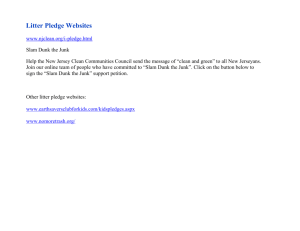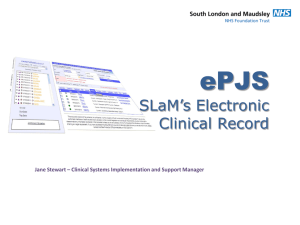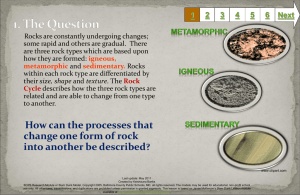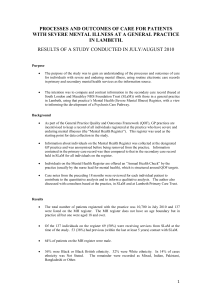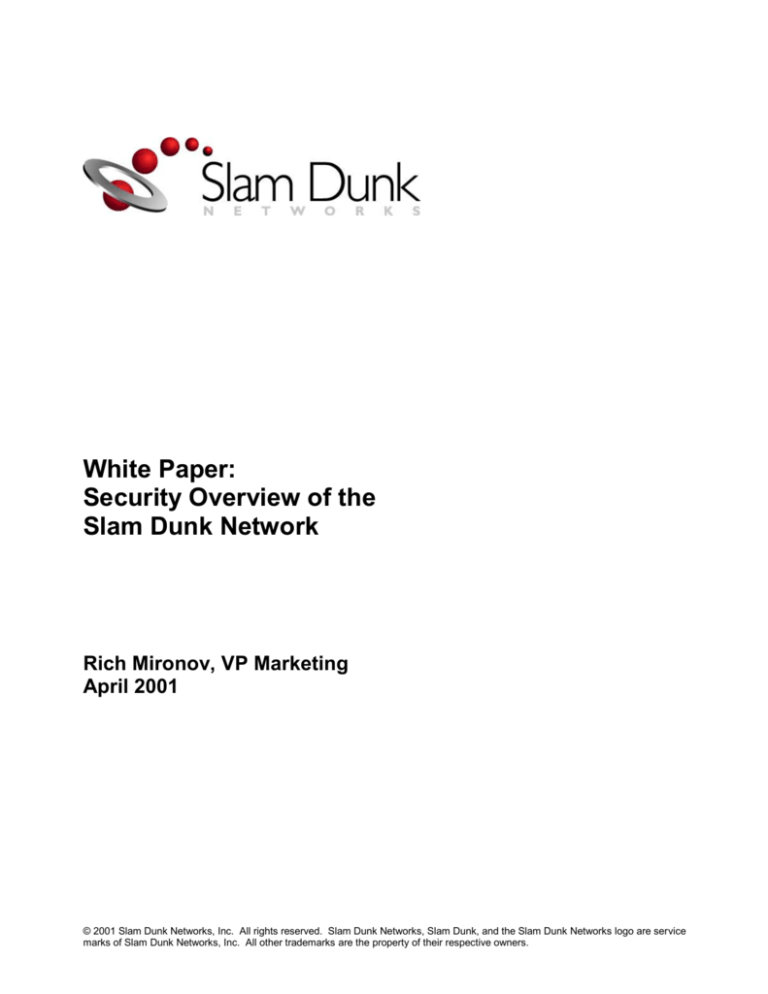
White Paper:
Security Overview of the
Slam Dunk Network
Rich Mironov, VP Marketing
April 2001
© 2001 Slam Dunk Networks, Inc. All rights reserved. Slam Dunk Networks, Slam Dunk, and the Slam Dunk Networks logo are service
marks of Slam Dunk Networks, Inc. All other trademarks are the property of their respective owners.
Table of Contents
1.
INTRODUCTION ................................................................................................................... 2
2.
PRIMARY SECURITY MECHANISMS ..................................................................................... 2
3.
ARCHITECTURE OF THE SLAM DUNK NETWORK ................................................................. 3
4.
MESSAGE SECURITY AND ENVELOPING .............................................................................. 4
PKC/PKI Overview ................................................................................................................ 5
PKC and Slam Dunk Message Security ................................................................................. 6
Connector Certificates and PKI ............................................................................................ 6
PKC and Communication Security ........................................................................................ 7
5.
ARCHIVE SECURITY ............................................................................................................ 8
6.
SUMMARY......................................................................................................................... 10
© 2001 Slam Dunk Networks, Inc.
1
SEC0401.05
1.
Introduction
Slam Dunk Networks, Inc., provides a uniquely valuable network service for corporate customers. The
service allows customers to exchange critical business information with their clients, suppliers, and trading
partners. The core benefits of the Slam Dunk Network include:
Rapid scaling and deployment to a wide range of customers and partners;
Guaranteed delivery, including delivery insurance;
Authentication of sender and receiver, with complete in-transit message security;
Delivery tracking and auditing;
Worldwide coverage.
Because the Slam Dunk Network handles corporate customers’ sensitive business information, the network
includes a comprehensive set of security measures to protect customers’ information from interception or
abuse. This white paper describes the major elements of the Slam Dunk security architecture, with
emphasis on how customer information is protected within the overall service objective of guaranteed
delivery.
Slam Dunk Networks uses industry-standard techniques and tools to ensure the
security of our customers’ messages, both during the delivery process and when
archived.
2.
Primary Security Mechanisms
Message-level security is the primary security mechanism of the Slam Dunk Network. Customer data is
enveloped as it enters the system, and remains enveloped in transit — all the way to the point of delivery.
Because of this multi-layered encryption, only the sender and recipient can decrypt and view message data.
Enveloping renders the original information unreadable to Slam Dunk employees as well as to external
users of the public Internet on which the Slam Dunk Network infrastructure is overlaid. Moreover, the
envelope includes information that uniquely identifies the sender and guarantees that only the identified
sender could have sent the message. In short, Slam Dunk Networks’ message-level security ensures
that only the intended recipient can read the message, and only the official sender could have
transmitted it.
The Slam Dunk Networks service also includes an online message archive. Using the mySlamDunk.net
portal, each customer has access to all messages that their systems have sent or received through the Slam
Dunk Network, including detailed log information about sender, receiver, time stamps, and the digital
content of each message. A customer’s access to the archive is protected not only by end-to-end datacommunications security between the customer’s system and archive systems, but also by authentication
and authorization features of the archive system itself. Access is permitted only after password-based
authentication, and access is granted only to the information for which the authenticated customer is
© 2001 Slam Dunk Networks, Inc.
2
SEC0401.05
authorized – i.e., messages that the customer has sent or received. Both the authentication exchange and
the subsequent exchange of archive information are protected by the encryption features of the
communication security service, the Secure Sockets Layer (SSL), an Internet standard used throughout the
World Wide Web and for many other applications as well.
Given these security mechanisms, all customer information is protected both in
transit and when stored, to ensure that each message’s data is available only to
the authenticated sender and receiver of the message.
Subsequent sections of this white paper describe each security feature in more detail, after a review of the
Slam Dunk Network’s basic architecture.
3.
Architecture of the Slam Dunk Network
The Slam Dunk Network has been engineered to guarantee delivery of application-level messages, ensuring
that transactions and critical information generated by customer systems are securely delivered to the
systems of the customer’s partner or customer. The Slam Dunk Network provides multiple delivery paths
and archives, security for message content, confirmation of delivery, and identity verification. Figure 1
summarizes the process for delivering a message via the Slam Dunk Network, and highlights the
advantages of its architecture.
Figure 1: Elements of the Slam Dunk Network
The phases of guaranteed delivery and tracking are:
1. The customer’s business application creates a message (or transaction) intended for a partner’s
remote business application. Since the Slam Dunk Network does not modify or manipulate message
contents, any data format or file structure can be used.
2. The source application gives the message to the onsite Slam Dunk Connector software, either
embedded in the sending application or running on its own system. The Connector is secured
© 2001 Slam Dunk Networks, Inc.
3
SEC0401.05
behind the customer’s firewall along with other protected applications. It requires no inbound
ports to be opened through the firewall, since it initiates outbound HTTP/S connections to
selected Hoops.
3. The Connector encrypts the transaction in a digital envelope. It then creates two identical copies
and sends each to a different Hoop within the Slam Dunk Network. The Connector uses its digital
certificate to create an envelope that identifies and authenticates itself as the point of origin of the
message. Each Connector’s authenticated identity is also used to identify the customer system on
behalf of which the Connector is working
4. Each Hoop stores copies of the transaction in two separate Online Data Stores (or archives).
5. Each Hoop then routes the transaction to the appropriate destination Connector behind the
recipient’s firewall.
6. The destination Connector delivers the first copy to the receiving application and creates a timestamped and digitally signed receipt. Delivery and receipt information is matched with the message
originally archived in the Online Data Stores.
7. When the second transaction copy arrives at the destination Connector, the Connector discards it,
guaranteeing that each item is delivered once and only once.
Both the customer and recipient can view message-level information through the mySlamDunk.net
portal, including time stamps for transmission and receipt. In addition, since the Online Data Stores retain
complete copies of each transaction, the encrypted message data can be retrieved in its entirety. Senders
and receivers with appropriate keys can view its contents.
By removing all single points of failure throughout the Slam Dunk Network
and routing dual copies of transactions over independent paths, Slam Dunk
avoids outages and slowdowns due to congestion or downed carriers. Every
message follows two fast routes to its destination, with positive
acknowledgment of delivery and contents available to both parties.
4.
Message Security and Enveloping
Message security in the Slam Dunk Network is implemented via cryptographic enveloping techniques. The
techniques used are industry standards that have been widely used and accepted — designed and reviewed
by industry experts in security. The Slam Dunk Network’s message security implementation uses standard
encryption algorithms such as RSA and AES, and standard data and message formats used worldwide for
secure messaging.
Message enveloping is based on the use of public-key cryptography (PKC), supported by Public Key
Infrastructure (PKI). Although these terms are commonly used interchangeably, this is not strictly correct.
A brief overview of applied PKC serves to illustrate how message security is implemented in the Slam
Dunk Network.
© 2001 Slam Dunk Networks, Inc.
4
SEC0401.05
PKC/PKI Overview
In PKC (public-key cryptography) systems, each party to a transaction possesses a cryptographic key that is
composed of two parts: a public key and a private key. The public key can be publicized and used by anyone
to encrypt a secret message that can be decrypted only by the private key. When using PKC, the general
assumption is that each party keeps their private key as a closely guarded secret, not shared with anyone.
Under this assumption, each party can encrypt a message only with the intended recipient’s public key, with
the assurance that only the intended receiver can decrypt and read the secret message after decrypting it
with their private key.
However, a message sender needs to obtain the public key of the intended recipient. A digital certificate is a
body of data that contains both a public key and information identifying the holder of the corresponding
private key. Certificates can be distributed in an ad hoc manner (e.g. Alice sends Bob her certificate so that
Bob can later send her secret messages) or via a directory service. The term “Public Key Infrastructure”
(PKI) is used to describe the various services and transactions that are needed to effectively use certificates
(see below).
In practice, PKC is rarely used to encrypt messages, because PKC algorithms are much more
computationally intensive than conventional cryptosystems, i.e., symmetric ciphers in which the same key is
used for encrypting and decrypting. Instead, a message is encrypted with a randomly generated “message
key” using a symmetric cipher, and the message key is encrypted with the recipient’s public key. The
encrypted message key is sent along with encrypted message. Again, only the holder of the recipient’s
private key can decrypt the message, because only that private key can decrypt the message key.
PKC can also be used to identify the sender of a message. A sender can encrypt a non-secret message with
her private key, and send the message (perhaps along with her certificate) to anyone. The recipient can use
the sender’s public key to decrypt the message. Because the message can be decrypted properly only with
the public key, only the corresponding private key could have encrypted the message. Therefore, the
message must have originated from the party holding the private key. Again, the certificate identifies the
party who holds the private key corresponding to the public key that the recipient used to encrypt the
message.
PKC also allows the sender to compute a short message digest (using a cryptographically strong one-way
function), and encrypt the digest with the private key. The sender sends the encrypted digest along with the
message, giving the recipient a way to verify the message’s contents. If the two digests match, then the
message originated from the sender described in the certificate containing the public key. The term digital
signature is often used to refer to a private-key-encrypted message digest; the process of computing one
from the message is signing, while the recipient’s decryption and comparison of digests is signature
verification.
© 2001 Slam Dunk Networks, Inc.
5
SEC0401.05
recipient's
public key
ENVELOPED MESSAGE
encrypted
message key
random
message key
encrypted
message key
Mary Sunshine
message
contents
encrypted
contents
encrypted
contents
digital
signature
Figure 2: Message Encryption, Keys and Enveloping
Slam Dunk customers have the option to turn off enveloping and encryption of the message contents.
This may be of value to partners if they apply encryption separately and want to reduce computational
overhead. In this case, Slam Dunk Networks’ session-level SSL still protects the contents from outside
viewing, and message contents are stored “as sent” in the online archive.
PKC and Slam Dunk Message Security
Message security in the Slam Dunk Network is a function of the sending and receiving Connectors. Every
Connector has both a private key and also a digital certificate that provides the corresponding public key
together with information identifying the Connector. As shown in Figure 2, a sending Connector envelopes
a customer’s transaction data by (a) encrypting it with a message key and the receiving Connector’s public
key, and (b) signing the data. The resulting message is transported through the Slam Dunk Network to the
receiving Connector. In transit, and as stored in the archive, the transaction data cannot be read, because
only the receiving Connector has the private key needed to open the envelope. When the message arrives at
the receiving Connector, the Connector decrypts the message, verifies the signature, creates the appropriate
log entries for the archive (time-stamped receipt, etc.), and delivers the transaction data to the receiving
application. Because the Connectors are co-located with the sending and receiving applications, in their
respective local networks, message security works end-to-end from the sender’s network to the recipient’s
network.
Enveloping and digital signatures combine to assure the receiver that
information has arrived intact from the correct sender.
Connector Certificates and PKI
Effective use of PKC requires a digital certificate infrastructure, usually called Public Key Infrastructure
(PKI), which consists of several services related to certificates including issuance, distribution, verification,
and validation. In addition, each application that uses certificates also needs some internal infrastructure
that allows application software to determine whether a given certificate is appropriate for use. A certificate
© 2001 Slam Dunk Networks, Inc.
6
SEC0401.05
might be perfectly acceptable in a formal sense, but should be used only if issued by an organization that is
trusted by the customer operating that application. The general trust issue can be summed up in a single
question from the point of view of an application examining a certificate: “This certificate says that
enclosed public key is Alice’s key; but who issued the certificate and why should I believe that the key is
really Alice’s, rather than someone who wants me to send them messages intended for Alice?”
Slam Dunk is a Registration Authority (RA) associated with VeriSign’s
Certificate Authority (CA). This RA status is part of Slam Dunk’s overall
partnership with VeriSign, and allows Slam Dunk to run the Verisign OnSite
application — creating trusted Class 1 certificates. Slam Dunk issues
certificates for mutual authentication of all network components.
In addition, customers may use their own digital certificates if they have a PKI and wish to generate a
certificate to be used in their Connector. Each Connector can be configured with a customer-provided
certificate in addition to the unit certificate, and in such cases the Connector uses both certificates. The
additional information in the customer certificate is included in the log entries for the archive.
Connectors rely on other parts of the supporting PKI for services in addition to certificate issuance. For
example, each Connector depends on a Slam Dunk Network component called “Slam Dunk Control”
(SDC). When a sending application sends transaction data to the sending Connector, the sending
application also identifies the recipient application. The Connector uses this identification information to
request the SDC to provide information about the Connector for the recipient application. Included in that
information is the digital certificate (or certificates) of the receiving Connector. To obtain the digital
certificate, the SDC relies on a certificate directory service that is part of the supporting PKI. Each time a
Connector certificate is created, it is also provided to the directory service. The certificate lookup operation
also includes other functions implemented in the PKI, including checks on the validity of the certificate.
Every element of the Slam Dunk Network includes its own digital certificate.
Network elements mutually authenticate each other before establishing any
communication, thus ensuring that no outsider can divert traffic or pretend to
be a component of the Slam Dunk Network.
PKC and Communication Security
Even though each customer transaction is enveloped using message-security techniques, and hence is not
visible in transit or in storage, it is still possible that potentially sensitive information could be obtained by
observing the transfer of enveloped messages through the Slam Dunk Network. For example, each
enveloped message is bundled with routing information that allows the various components of the Slam
Dunk Network to properly deliver the message. Hence, observers might obtain knowledge about the
sender and recipient, even though the observers could not see the un-encrypted version of the actual data
sent to the recipient.
Consequently, all communications between elements of the Slam Dunk Network are encrypted using the
industry-standard communication security protocol SSL. When a Connector forwards an enveloped
message to a Hoop, the following SSL protocol steps take place in the Connector and Hoop:
© 2001 Slam Dunk Networks, Inc.
7
SEC0401.05
1. The Connector’s SSL software contacts the Hoop’s SSL software to request the setup for an
encrypted communication session.
2. The Hoop replies with its digital certificate.
3. The Connector validates the Hoop’s certificate to determine whether this Hoop is actually a
legitimate component of the Slam Dunk Network.
4. If the certificate is valid, the Connector uses the Hoop’s public key (contained in the Hoop’s
certificate) to exchange a dynamically generated session key and other information necessary for the
two parties to set up an encrypted connection (e.g., negotiating which symmetric cipher to use).
5. After exchanging the session key, the Connector can use it to encrypt all the data it sends to the
Hoop; the Hoop, in turn, can use the session key to decrypt the data it receives from the
Connector. Conversely, the Hoop can use the session key to encrypt all the data it sends to the
Connector, and the Connector can use the session key to decrypt the data it receives from the
Hoop.
The same security functions are applied whenever any Slam Dunk Network component communicates
over a network with any other component, whether it be Connector-to-Hoop, Hoop-to-Connector,
Connector-to-SDC, or any other type of internal communication within the Slam Dunk Network. In
addition, some kinds of communication are specifically disallowed: no Connector has a need to
communicate directly with an Online Data Store, so these network elements are blocked from talking with
each other.
Every operation in the Slam Dunk Network is protected from observation by
anyone with access to the network media or network services upon which the
Slam Dunk Network is built.
5.
Archive Security
In addition to message delivery, a key part of the Slam Dunk service is customer access to the
mySlamDunk.net portal and message archive. This allows customers to view information about messages
that they have sent or received, as well as retrieve encrypted message content. As shown in Figure 3, the
Slam Dunk archive includes:
Message delivery date, time and size
Reply (receipt) date, time and size
Partner identification
Full message content as provided to Slam Dunk Networks. Archiving allows sender and receiver to
recapture the complete message, in case either party has questions about the information sent. Since
message content is normally encrypted, customers will require the appropriate keys to decrypt a
message, and Slam Dunk employees will not be able to decipher it.
© 2001 Slam Dunk Networks, Inc.
8
SEC0401.05
Customers can choose a “no storage” option for the online archive, which deletes message contents
immediately upon confirmation of delivery. This option can be used for additional message protection or
for content that has no ongoing archive value.
Figure 3: mySlamDunk.net portal
Security of the archive depends on three security functions:
1. Communication Security: As with all communication in the Slam Dunk service, SSL is used to encrypt
communication between a customer’s browser and the web-based portal to the archive service.
2. Authentication: Access is granted only when the user can authenticate via a user ID and password for a
specific customer/user account. Each master user account is created and maintained by Slam Dunk
Networks, Inc., and used by individuals deemed appropriate by the customer. Master users can create
additional user IDs/passwords as desired, and manage them as needed. The password-based
authentication dialogue occurs with the SSL session in order to prevent password eavesdropping.
3. Authorization and Access Control: the archive’s application software provides each user with access to only
the information for which that user is authorized, according to the access control policy of the archive.
The policy is simple. Each unit of information in the archive is about a transaction between a sender
and receiver, and can be accessed only by the user ID associated with the sender, the user ID associated
with the receiver, or a user ID of an administrator of the Slam Dunk Network. (Slam Dunk
administrators must authenticate using the same mechanisms as corporate users.)
© 2001 Slam Dunk Networks, Inc.
9
SEC0401.05
The effectiveness of these archive security mechanisms depends also on the proper deployment and
management of the archive components of the Slam Dunk Network. Like all components, archive
components are deployed and maintained by Slam Dunk Networks, Inc. using industry-standard
deployment security techniques and best practices, including:
Physical and logical separation of the production messaging infrastructure from all corporate
infrastructure;
Multi-layered network and firewall architecture with all access (firewall ports) restricted and filtered
to minimum production requirements;
Hardened operating systems on all servers;
Access to production equipment restricted to authorized personnel only; enforcing as-needed
access by 7x24 security guards, positive identification, cameras, and locked cages/rooms
Limited and segmented remote access to all equipment by Network Operations Center personnel
utilizing call-back and VPN;
Yearly external security assessment.
The Slam Dunk management team has many years of experience running secure facilities and network
operations centers. We have taken advantage of this experience to create a state-of-the-industry
management and monitoring facility.
Slam Dunk’s production systems and operations, including the
mySlamDunk.net portal, use industry-standard security solutions and best
practices to protect information about messages, delivery, and partners.
6.
Summary
The Slam Dunk Network has been designed from its inception with security in mind. This provides
customers with the assurance that their critical business information will remain private and protected.
Specifically, Slam Dunk security includes:
Message-level security protecting each customer transaction while in transit;
Session-level security to keep traffic among network components invisible to outsiders; and
Application-level authentication, authorization, and access control for customer access to archive
data.
Slam Dunk Network, Inc. was created to deliver a higher level of service and security than customers
expect. Readers are invited to explore security issues further with their Slam Dunk account team.
© 2001 Slam Dunk Networks, Inc.
10
SEC0401.05

